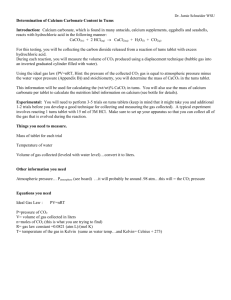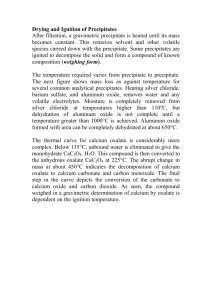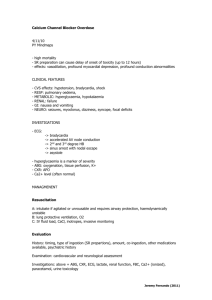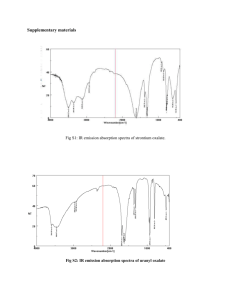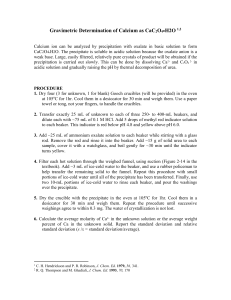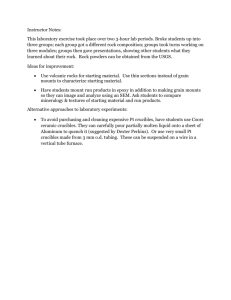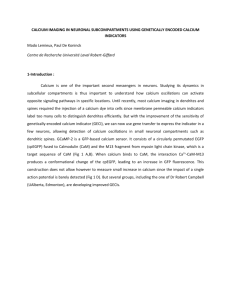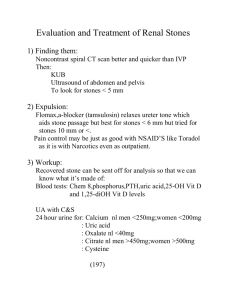Experiment 1-1: Acid-Base Titrations and Chemical Indicators
advertisement
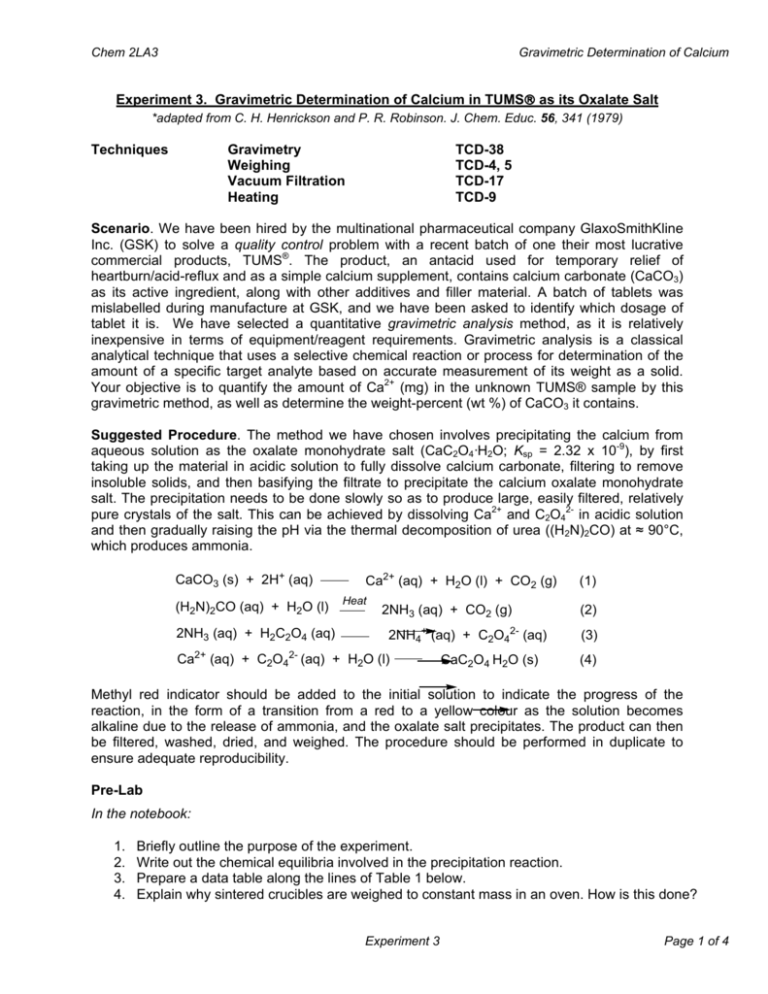
Chem 2LA3 Gravimetric Determination of Calcium Experiment 3. Gravimetric Determination of Calcium in TUMS as its Oxalate Salt *adapted from C. H. Henrickson and P. R. Robinson. J. Chem. Educ. 56, 341 (1979) Techniques Gravimetry Weighing Vacuum Filtration Heating TCD-38 TCD-4, 5 TCD-17 TCD-9 Scenario. We have been hired by the multinational pharmaceutical company GlaxoSmithKline Inc. (GSK) to solve a quality control problem with a recent batch of one their most lucrative commercial products, TUMS®. The product, an antacid used for temporary relief of heartburn/acid-reflux and as a simple calcium supplement, contains calcium carbonate (CaCO3) as its active ingredient, along with other additives and filler material. A batch of tablets was mislabelled during manufacture at GSK, and we have been asked to identify which dosage of tablet it is. We have selected a quantitative gravimetric analysis method, as it is relatively inexpensive in terms of equipment/reagent requirements. Gravimetric analysis is a classical analytical technique that uses a selective chemical reaction or process for determination of the amount of a specific target analyte based on accurate measurement of its weight as a solid. Your objective is to quantify the amount of Ca2+ (mg) in the unknown TUMS® sample by this gravimetric method, as well as determine the weight-percent (wt %) of CaCO3 it contains. Suggested Procedure. The method we have chosen involves precipitating the calcium from aqueous solution as the oxalate monohydrate salt (CaC2O4·H2O; Ksp = 2.32 x 10-9), by first taking up the material in acidic solution to fully dissolve calcium carbonate, filtering to remove insoluble solids, and then basifying the filtrate to precipitate the calcium oxalate monohydrate salt. The precipitation needs to be done slowly so as to produce large, easily filtered, relatively pure crystals of the salt. This can be achieved by dissolving Ca2+ and C2O42- in acidic solution and then gradually raising the pH via the thermal decomposition of urea ((H2N)2CO) at ≈ 90°C, which produces ammonia. CaCO3 (s) + 2H+ (aq) (H2N)2CO (aq) + H2O (l) 2NH3 (aq) + H2C2O4 (aq) Ca2+ (aq) + H2O (l) + CO2 (g) Heat 2NH3 (aq) + CO2 (g) 2NH4+ (aq) + C2O42- (aq) Ca2+ (aq) + C2O42- (aq) + H2O (l) CaC2O4 H2O (s) (1) (2) (3) (4) Methyl red indicator should be added to the initial solution to indicate the progress of the reaction, in the form of a transition from a red to a yellow colour as the solution becomes alkaline due to the release of ammonia, and the oxalate salt precipitates. The product can then be filtered, washed, dried, and weighed. The procedure should be performed in duplicate to ensure adequate reproducibility. Pre-Lab In the notebook: 1. 2. 3. 4. Briefly outline the purpose of the experiment. Write out the chemical equilibria involved in the precipitation reaction. Prepare a data table along the lines of Table 1 below. Explain why sintered crucibles are weighed to constant mass in an oven. How is this done? Experiment 3 Page 1 of 4 Chem 2LA3 Gravimetric Determination of Calcium 5. Explain the function of urea and the need for heat to initiate the precipitation reaction. 6. Explain how calcium carbonate neutralizes excess stomach acid. Write the chemical equilibria involved in the process. What is the pKb of carbonate (CO32-)? 7. Explain which of the following calcium salts is least soluble at 25°C at pH 7 – which reagent, oxalate or sulphate would be best used in a quantitative precipitation reaction? CaC2O4.H2O; Ksp = 2.32 x 10-9 CaSO4.2H2O; Ksp = 3.14 x 10-5 Directions Your sample of crushed and pre-dried TUMS® will already be available to you in a desicator. You will also be provided with stock solutions of urea, ammonium oxalate and HCl. (a) Drying Crucibles 1. Bring two crucibles to constant weight – start by labeling the crucibles with a lead pencil and placing them in the oven at 105 oC to dry for at least one hour. 2. Continue to Part (b) – resume during Part (c), step 3. (b) Preparation of the Sample 1. Accurately weigh out 2 samples of about ≈ 0.35g of the dried TUMS® tablet powder and record the exact mass in your lab notebook to the nearest 0.1 mg. 2. Transfer each of the samples into a clean dry 250 mL beaker. 3. To each sample add 100 mL of concentrated urea solution and slowly add 6 mL of 6 M HCl as you swirl the solution to dissolve the sample. Repeat for the other sample. 4. Swirl the solutions for about 5-10 min until dissolution is complete. If there are insoluble particulates still remaining in solution, set up a gravity filtration apparatus and filter out the particulates while ensuring you keep all the filtrate and any water used for rinsing. 5. Use pH paper to test if the solution has a pH ≈ 1. To do this, touch the solution with a glass rod, place the rod on the pH paper, and note whether it turns pinkish red. If it doesn’t, add 1-2 drops of 6 M HCl and test the pH of the solution again. Repeat as many times as necessary. 6. Add 4 drops of the methyl red indicator to both samples and swirl the solutions. 7. Add 20 mL of saturated ammonium oxalate solution to both samples. (c) Precipitation of Calcium Oxalate Monohydrate 1. Prepare a heating/stirring plate in the fumehood and place the two beakers on top of the plate with a watch glass covering each beaker. 2. Heat the solutions to near-boiling or when condensation occurs and continue until the solution colour changes from red to white due to slow precipitate formation. Ensure that the flasks are evenly centered on the hot plate. This should take ≈ 50 min; if it does not change within an hour, turn off the heat and allow the solution to cool. Record all your observations in your notebook! 3. While your solutions are heating, finish weighing the sintered glass crucibles to constant weight. Remove them from the oven and allow them to cool for at least 5 min. Weigh the cooled crucible while wearing gloves or using tongs so as to not alter the mass. Perform cycles of “heat 5 min, cool 5 min, weigh” until two consecutive masses differ by no more than 0.3 mg. Record the final weights of the crucibles. Place the crucibles in the desicator until ready for later use. Experiment 3 Page 2 of 4 Chem 2LA3 Gravimetric Determination of Calcium 4. Set up vacuum filtrations using the sintered glass crucibles as the funnels and isolate the solid. Add a small amount of distilled water to wash left-over solids in the beaker and pour it into the crucible.Be quantitative! 5. Wash the solid with 2 x 10 mL portions of distilled water and then with 2 x 10 mL portions of acetone. 6. Leave the crystals to dry in the air for 15 min. 7. Heat the solid in the oven for 5 min intervals in the same manner as you did with the empty crucibles, until the product has reached constant mass. 8. Record the final mass and use it to determine the amount of Ca2+ and the weight percent of calcium carbonate in the sample. Table 1. Sample Data Table for Gravimetric Analysis of Ca2+ as its Oxalate Salt Aliquot 1 Aliquot 2 Mass of TUMS sample (g) Mass of Crucible (g) Mass (Crucible+CaC2O4.H2O) (g) * after repeated drying * Mass CaC2O4.H2O (g) Moles CaC2O4.H2O Mass Ca2+ in sample (mg) wt% CaCO3 in TUMS sample Mass of Ca2+ per table (mg) Waste Disposal Dispose of strong acid in the acid waste container, and aqueous solutions in the aqueous waste container. Dispose of solids in the Solid Waste Container. Conclusions Report the average mass of Ca2+ per tablet and the average wt% CaCO3 the unlabelled TUMS® sample contains, as well as your observations during the precipitation reaction. What percentage of a tablet is essentially inert filler material? Which one of the following three possible dosages of TUMS® is the mislabeled unknown sample you analyzed? Calculate the % error (accuracy) of your result – comment? Regular Strength: 200 mg Ca2= Extra-strength: 300 mg Ca2+ Ultra-strength: 400 mg Ca2+ References 1. C. H. Henrickson and P. R. Robinson. J. Chem. Educ. 56, 341 (1979). th 2. D. C. Harris. Exploring Chemical Analysis, 4 Edition, Ch.3, 4, 7: W.H. Freeman and Company: New York, NY, 2009. 3. http://www.tums.ca/faq_contents.aspx Experiment 3 Page 3 of 4 Chem 2LA3 Gravimetric Determination of Calcium EXPERIMENT 3. REPORT SUMMARY: GRAVIMETRIC DETERMINATION OF CA Date: Student Name: TA Name: Sample ID: Sample Data Table for Gravimetric Analysis of Calcium as Oxalate Salt Replicate 1 Replicate 2 Mean + Std Dev. Data Mass CaCO3 (g) Mass of Ca2+ in sample (mg) % CaCO3 in sample Mass of Ca2+ per tablet (mg) Your TA will provide you the average dried weight of a single TUMS tablet in class Dosage of unlabelled TUMS®? % Error: % CaCO3 wt in sample? % Inert filler material wt? Experiment 3 Page 4 of 4
